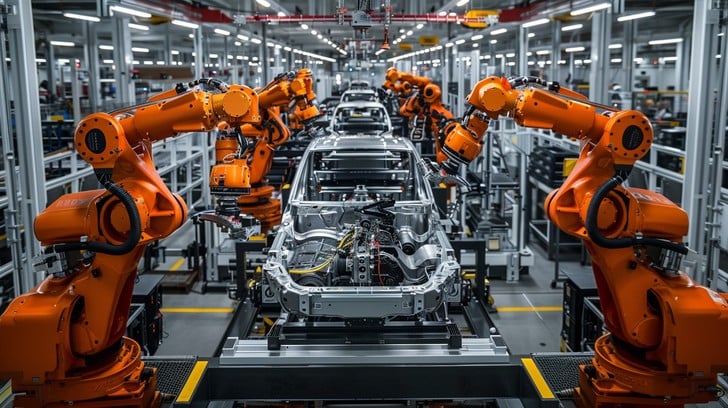
Over the past few years, few supply chain disruptions have hit the auto industry as hard as the global semiconductor shortage. The crisis forced manufacturers to cut millions of vehicles from production schedules and cost the industry hundreds of billions of dollars. As we move forward, many in the automotive and auto parts sectors are asking: Can we prevent this from happening again?
The Ongoing Impact of the Chip Shortage

According to AutoForecast Solutions, the semiconductor shortage caused automakers to cancel nearly 15 million units from global production schedules in 2021 and 2022. In 2021 alone, the estimated financial loss reached $210 billion.
The effects were felt not only by carmakers, but also by consumers and parts suppliers. With fewer new vehicles being manufactured, the prices of new and used cars skyrocketed. The U.S. Bureau of Labor Statistics reported that the Consumer Price Index (CPI) for new vehicles increased only 0.47% from 2015 to 2020, but jumped 22% from 2020 to mid-2023. Meanwhile, the used vehicle CPI rose by an astonishing 41.7% in that same period.
Although the shortage began to ease in 2023, its impact persists. Automakers had already cut 524,000 units in the first half of the year. Projections suggest that over 2 million vehicles may be removed from production by the end of 2023.
What Caused the Semiconductor Shortage?
Just-in-Time Manufacturing
The automotive industry has long relied on just-in-time (JIT) manufacturing to control costs and reduce waste. While efficient under stable conditions, JIT offers little flexibility when unexpected events occur. The COVID-19 pandemic triggered factory closures and disrupted logistics globally. Because auto manufacturers and suppliers maintained minimal inventory under the JIT model, they had little cushion when chip deliveries stopped.
Geopolitical Conflicts
Trade tensions between the U.S. and China, including tariffs and export restrictions on chip-making technology, have strained global supply. In addition, Russia’s invasion of Ukraine disrupted the supply of neon gas, which is critical in semiconductor production. Ukraine previously supplied half of the world’s neon.
Rapidly Growing Demand
The shift toward electrification and advanced vehicle technologies increased demand for semiconductors. Features like driver-assistance systems, digital dashboards, and EV powertrains require more chips than ever. On average, EVs use twice as many semiconductors as traditional internal combustion vehicles. As EV sales grow worldwide, so does demand for chips.
How the Industry Is Responding
Strategic Supplier Partnerships
To secure future chip supplies, automakers are entering long-term agreements with chip manufacturers. For instance, General Motors partnered with GlobalFoundries, while Stellantis signed multi-billion-dollar deals with Infineon Technologies, NXP Semiconductors, and Qualcomm.
Auto parts suppliers are doing the same. BorgWarner expanded its partnership with Onsemi, and Bosch invested over $1.5 billion in its California-based chip production facility.
Investing in Domestic Chip Production
The U.S. government is incentivizing domestic chip manufacturing through the CHIPS Act, which allocates over $50 billion for the cause. As a result, companies have announced over $160 billion in new investments in American semiconductor facilities. This trend aims to reduce dependency on foreign suppliers and mitigate geopolitical risks.
Rethinking Production Models
Some companies are moving away from pure JIT manufacturing and adopting hybrid approaches. Toyota, for example, has begun stockpiling semiconductors. Others are integrating artificial intelligence and data analytics into their supply chains to better anticipate disruptions.
Ongoing Challenges
Despite progress, several risks remain:
- U.S.-China Trade War: The conflict shows no signs of easing. New export restrictions and investment bans could further strain chip availability.
- Supply Chain Bottlenecks: Global neon gas supplies remain limited due to the Ukraine conflict, and China has introduced export controls on gallium and germanium.
- Surging Demand: EV adoption is accelerating. Experts predict that the U.S. auto industry alone may need 3 billion more chips annually by 2028.
What It Means for the Auto Parts Sector
Auto parts retailers and suppliers are directly impacted by chip shortages, even if they don’t produce semiconductors themselves. When vehicle production slows, demand for OEM and aftermarket parts shifts unpredictably. For example:
- Repair shops may see increased demand for replacement parts as consumers hold on to vehicles longer.
- Diagnostic equipment and electronic modules may be delayed or priced higher due to chip shortages.
- EV-specific parts that rely on semiconductors, such as inverters and control units, become harder to source.
Suppliers and resellers should consider diversifying their vendor base, increasing inventory buffers for electronics, and building closer relationships with Tier 1 and Tier 2 manufacturers.
Preparing for the Next Disruption
To avoid repeating the mistakes of the past, the auto industry must make resilience a priority. Here are some key takeaways:
- Diversify supply chains geographically to reduce dependence on single regions.
- Invest in domestic manufacturing to insulate from global conflicts.
- Balance efficiency with flexibility by maintaining strategic reserves.
- Leverage data and AI for smarter demand forecasting and inventory management.
Conclusion

The chip shortage was a wake-up call for the global auto and auto parts industry. While some vulnerabilities have been addressed, many systemic risks remain. By investing in more resilient supply chains, embracing smarter production practices, and collaborating across sectors, the industry can better prepare for whatever comes next.
For auto parts suppliers, that means being proactive—anticipating shifts in demand, securing key product lines, and staying informed on changes in the semiconductor landscape. Whether you’re sourcing sensors, ECUs, or EV modules, the path forward is one of adaptability and awareness. The next shortage may come without warning, but being ready can make all the difference.



